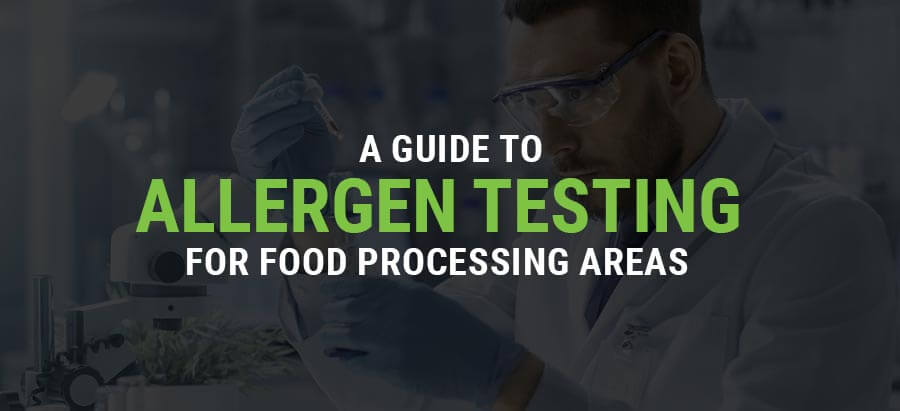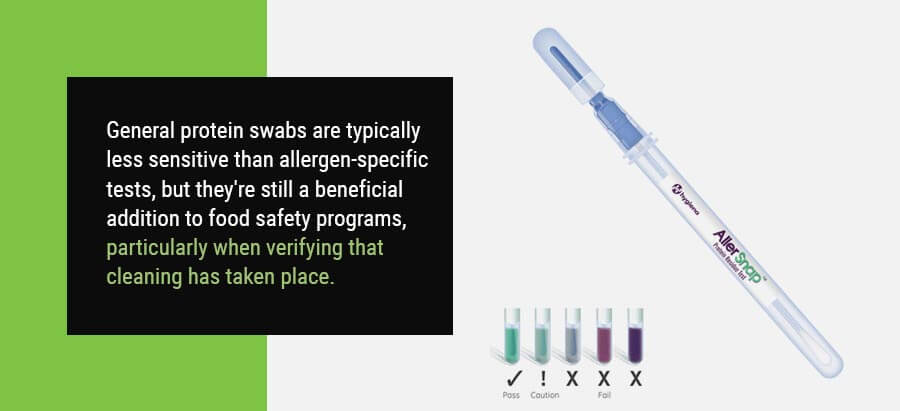A Guide to Allergen Testing for Food Processing Areas
Oct 7th 2022

If you're familiar with food allergies, you know the consequences can range from a minor skin rash to anaphylactic shock. The only foolproof way to prevent these reactions is to avoid contact with food allergens altogether.
For these reasons, food labeling guidelines require businesses to list any allergens on the packaging, whether as a main ingredient or potential presence. The health — and in many cases, life — of many consumers depends on the validity of this information.
While improper package labeling and undeclared allergens are significant causes of product recalls, food companies are also responsible for preventing cross-contamination in processing plants, making thorough allergen testing a must. This article explores the different types of protein swabbing kits for food safety.
What Is Allergen Testing?
Protein is in most foods — nuts, soy, eggs, shellfish and milk, to name a few. And while many vegetables and fruits have minimal protein, they can still trigger allergic reactions in some people. Because food proteins tend to trigger most allergic reactions, you'll want to remove them from the work environment as much as possible.
If food contamination or inaccurate labeling occurs, a person with allergies can experience a potentially fatal reaction called anaphylactic shock. For this reason, the Codex Alimentarius Commission has established science-backed standards to ensure the safest practices regarding allergens. Many countries have implemented comprehensive food allergen testing and labeling practices based on Codex guidelines.
Codex has listed the foods and ingredients known to cause the most severe allergic reactions and food hypersensitivity cases. These include:
- Cereals containing gluten, including rye, wheat, oats and barley
- Crustaceans
- Eggs
- Fish
- Milk
- Peanuts
- Soybeans
- Tree nuts
If you can confirm work surfaces are essentially free of protein, you can infer these surfaces won't contaminate your food products with traces of allergens. Here is where allergen testing comes into play.
What Proteins Can Allergen Test Swab Kits Detect?
While some food allergen test kits in the food industry can't distinguish between different proteins and ingredients, others detect traces of specific pathogens. Below, we'll explore the different types of allergen swab testing kits and what they can identify.
General Protein Surface Testing
A popular and reliable method, general protein surface testing — such as AllerSnap protein residue tests — checks for the presence of protein on a given surface, as the name implies. These tests don't differentiate between protein from meats, nuts, dairy or other ingredients — any protein will trigger an allergic reaction. Kits like AllerSnap swabs also require extra equipment like an incubator and heating blocks.

General protein swabs are typically less sensitive than allergen-specific tests, but they're still a beneficial addition to food safety programs, particularly when verifying that cleaning has taken place. If no test kit is available to screen for a specific allergen, verification from an AllerSnap kit can come in handy. However, don't use protein swabs alone for allergen control, as they can only work on surfaces and identify protein molecules with no differentiation.
General protein surface testing involves swabbing the surface, then incubating the sample before reading the result. Some methods don't require an incubation period, but these tend to be less sensitive — and less suitable — for allergen cleaning. However, all rapid protein surface testing methods will prompt the sample to change colors during incubation or when mixed with the reagent.
Rapid Testing for Specific Allergens
A range of on-site lateral flow devices can pinpoint specific allergens, like AlerTox Sticks. They can detect allergenic material in surface samples, food samples and rinse water samples. As you can likely imagine, they're more specific and sensitive than general protein swabs.
Specific allergen testing kits come in handy when you're trying to prove your cleaning program works. The process is as simple as ordering a test kit, then blocking off roughly 15 minutes on your schedule. Kits such as AlerTox Sticks are especially ideal for high-stakes allergen cleaning and monitoring of incoming ingredients. They don't require additional equipment and can identify various allergens, including:
- Crustacean
- Almond
- Egg
- Milk
- Hazelnut
- Mustard
- Soy
- Peanut
- Walnut
Unlike AllerSnap and other general protein swab skits, specific allergen tests have antibodies that react to small amounts of distinct proteins. For instance, a kit designed to detect traces of peanuts will essentially “ignore” protein from ingredients like soy, milk or chicken. This ability to differentiate generally makes them the superior choice for high-risk circumstances, in addition to program validation when there are changes to your environment, ingredients, process or team.
Remember, many of these tests only provide qualitative results, where they merely indicate the presence or absence of an allergen. Quantitative results are more comprehensive and also tell you the allergen concentration.
Advantages of Allergen Protein Swab Kits
Now that we've explored the different types of allergen testing in the food industry, let's review the primary benefits of protein swab kits:
- Specific methods can detect proteins from a multitude of allergens.
- You can use some on rinse water and other products in addition to surfaces.
- They provide quick results, typically 15 to 30 minutes, depending on incubation.
- They're cost-effective and allow for the collection of multiple data points.
- They're easy to use and interpret.
As we briefly touched on earlier, there are also a couple of disadvantages to protein swab allergen kits, such as:
- General protein surface testing methods can't detect specific allergens.
- Some tests require additional equipment and time to perform.
- Specific allergen testing methods only provide qualitative results.
How to Choose the Best Allergen Testing Method
Because each allergen testing method provides various benefits and limitations for food-related businesses, there's no right or wrong answer. When choosing the correct allergen testing method, it helps to use the following questions as guidelines:
- What is the purpose of the allergen swabbing procedure — e.g., determining the effectiveness of sanitation and cleaning, monitoring allergen management practices or investigating a cross-contamination incident?
- What and how many allergens are we testing?
- Is the food we are testing highly processed?
- What is our availability of lab equipment and trained personnel?
- How soon do we need the results?
Allergen Test Kits From QA Supplies
Take your quality control and safety to a new level with QA Supplies. Since 1995, we've provided thousands of competitively priced products, accommodating those who monitor environmental conditions to ensure the quality of fresh produce, meat, dairy and poultry. We offer multiple types of allergen testing for food safety so you can efficiently detect potential allergens in foods, beverages and surfaces.
Some of our tests require incubators and heating blocks, while others are entirely self-sufficient. No matter the type you choose, many of our tests generate results within 15 to 30 minutes, so you can perform any necessary corrective measures as quickly as possible. Browse our selection of food allergen test kits and incubators today!


